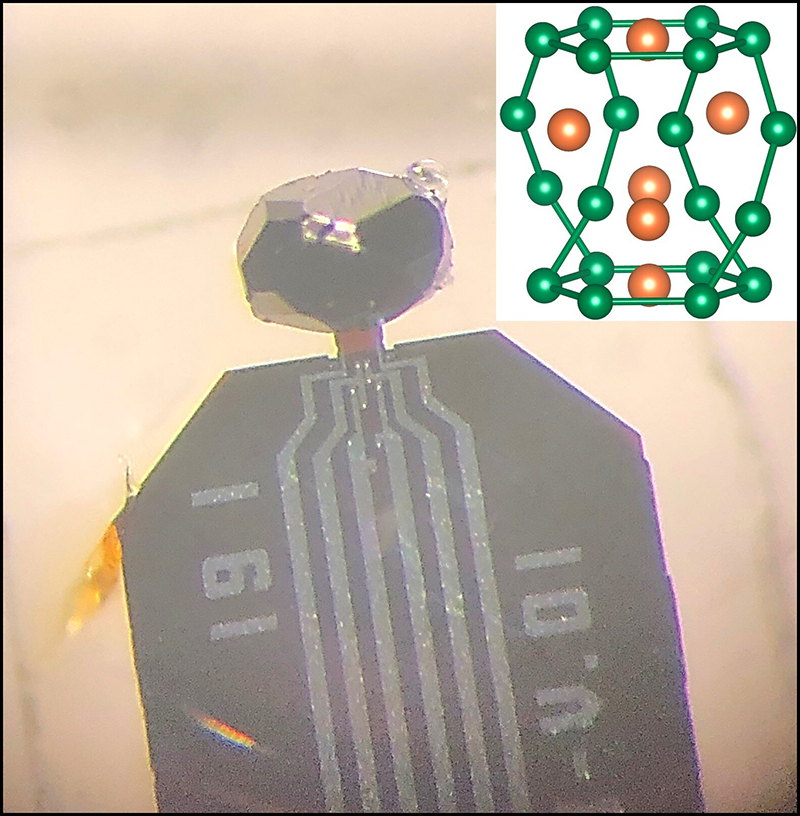
Posted on 09/08/2021 10:50:32 AM PDT by Red Badger
In metals, electrons are normally expected to be diffusive in their movement, operating as individual particles – in other words, they don't gain momentum as a group.
In a new study, scientists have now discovered a type of metal where electrons actually do flow in a fluid-like way – like water in a pipe – by interacting with quasiparticles called phonons, which emerge from vibrations in a crystal structure.
This causes the electrons to shift from diffusive (particle-like) to hydrodynamic (fluid-like) behavior in their movement.
The metal superconductor that causes this behavior is a synthesis of niobium and germanium called ditetrelide (NbGe2), the research team reports. Potentially, it could give rise to a new type of electronic device.
"We wanted to test a recent prediction of the 'electron-phonon fluid'," says experimental physicist Fazel Tafti from Boston College.
"Typically, electrons are scattered by phonons which leads to the usual diffusive motion of electrons in metals. A new theory shows that when electrons strongly interact with phonons, they will form a united electron-phonon liquid. This novel liquid will flow inside the metal exactly in the same way as water flows in a pipe."

Above: A small crystal of the new material on a device, with the inset showing the atomic arrangement.
Three experimental methods confirmed the electron-photon fluid hypothesis put together by Tafti and his colleagues. The first was the measurement of electrical resistivity in the metal, which showed its electrons had a higher mass than would normally be expected.
Second, Raman scattering laser analysis showed that the vibration of NbGe2 changed because of the unusual flow of electrons, and finally X-ray diffraction techniques revealed the crystal structure of the metal.
The mass of electrons was three times larger than it should be, a material mapping approach known as quantum oscillations showed: another sign that the electrons and phonons were causing unusual behavior.
"This was truly surprising because we did not expect such 'heavy electrons' in a seemingly simple metal," says Tafti.
"Eventually, we understood that the strong electron-phonon interaction was responsible for the heavy electron behavior. Because electrons interact with lattice vibrations, or phonons, strongly, they are 'dragged' by the lattice and it appears as if they have gained mass and become heavy."
There's currently a lot of research interest in the idea of electron-phonon liquids, even if it's not fully clear yet what the implications might be for the electronic gadgets and communication systems of the future.
This new work opens up plenty of interesting options for future research. Next, the researchers want to find other materials that behave in the same way as NbGe2, and to work on controlling the fluid flow of electrons for future applications.
"Whereas electron-phonon scattering relaxes the electron's momentum in metals, a perpetual exchange of momentum between phonons and electrons may conserve total momentum and lead to a coupled electron-phonon liquid," the researchers explain in their study.
"Such a phase of matter could be a platform for observing electron hydrodynamics."
The research has been published in Nature Communications.
Liquid Electrons Ping!...............
It’s “Reardon Metal”
Iron Maiden!
This might make sense if its durability is higher in some applications.
Not sure what you’d use it for otherwise. A wire is pretty easy and low tech enough to run through most places.
Electrons moving in single file produce huge amounts of energy.
Now, imagine them in bunches and huge ones!...............
A probalistic fluid?
I doubt this…
Pro Ballistic?..................
Electrons moving in single file
***Atoms also.
https://www.lenr-forum.com/forum/thread/5859-1-dimensional-lenr-theories/
Look for my V1DLLBEC theory of LENR.
Vibrating 1 Dimensional Luttinger Liquid Bose Einstein Condensate

Now that you mention it …😳
Make the electrons bigger. Make the mass of the hydrogen bigger. Make the lattice holding them in smaller or more absorbent of Hydrogen/Deuterium. Ya get more control over the whole interaction, with the probabilistic fusion cross-section growing exponentially.
Electrons flow like a fluid in all metals. Well, a fluid flowing through a column of sand, but still.
Apparently these electrons flow in groups!................
The fork I stuck in the outlet was made of that stuff.
This is interesting.
It’s also interesting that at high frequencies AC travels through a conductor on the outside...it’s called the skin-effect. i.e. The coaxial cable feeding a transmitter need only be copper on the outside of the conductors, cheaper aluminum can be used for the rest...the copper plating carries the load..
If you can get a hydrogen atom to lock electrons with this crystal, then have them stripped away, while simultaneously putting the two protons that are left together....................
Plus, consider their spin. As they bump into each other on a linear string, their spins align. That helps form a high temperature BEC.
they dont really state any clear benefits
i mean do they flow with a lot less friction (heat)
do they flow magnitiudes of times easier through this than regular metal?
is the new metal more durable than standard wires?
can we wrap a saucer in the new metal and spin it and go into orbit in 2 seconds?
it would be nice for some kind of practical ideas how this might be applied.
Bouncing balls in linear alignment: Astroblaster
https://youtu.be/2UHS883_P60
Basically, if a linear “AstroBlaster” tube effect can be in place, then the 1 dimensional collisions are amplified and may be enough to overwhelm the Coulomb barrier and cause Fusion.
How would a linear tube effect happen? By constraining the degrees of motion for Hydrogen trapped in a lattice structure of Nickel, or Deuterium trapped in a lattice structure of Paladium. The atoms will collide on a 1 dimensional path.
Disclaimer: Opinions posted on Free Republic are those of the individual posters and do not necessarily represent the opinion of Free Republic or its management. All materials posted herein are protected by copyright law and the exemption for fair use of copyrighted works.